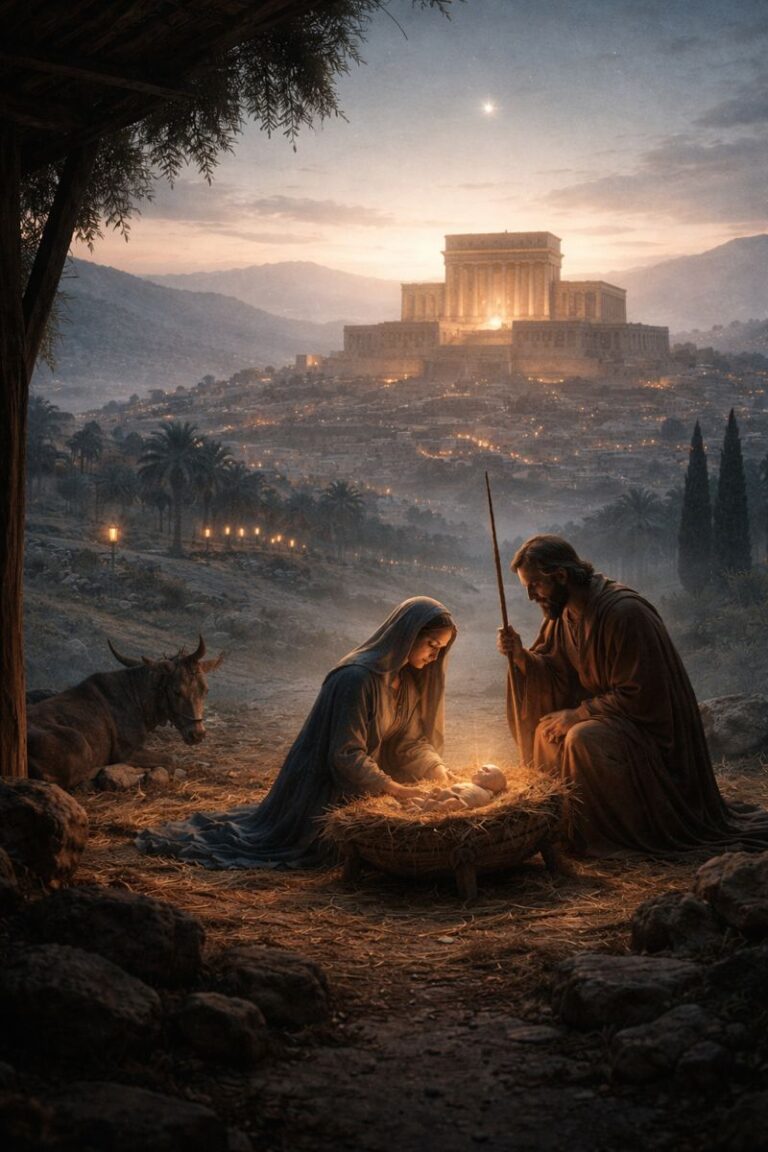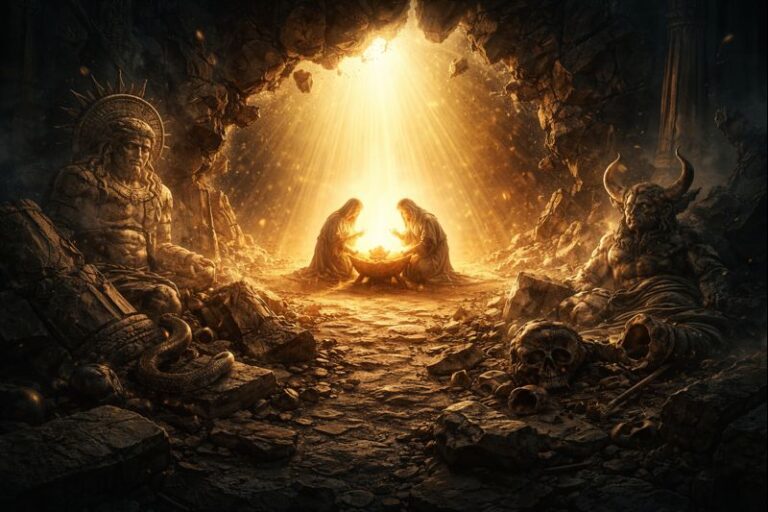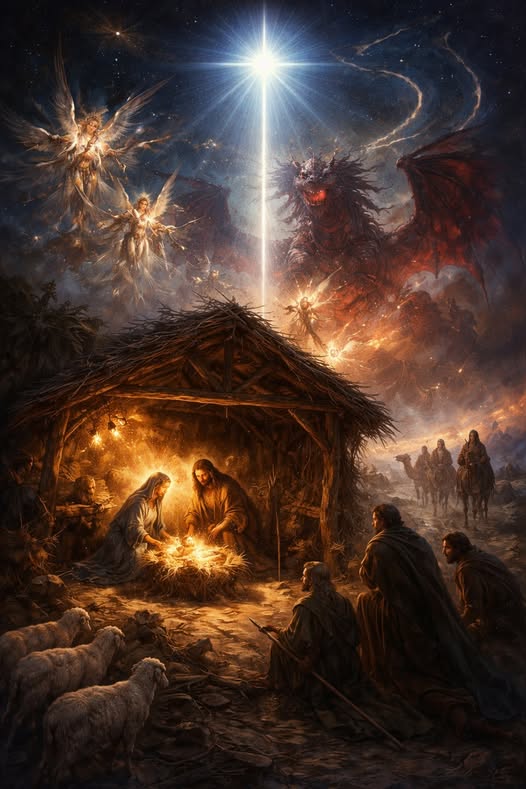
Throughout Scripture, a pattern emerges—one that contrasts the fall of those who grasp at divinity with the exaltation of those who receive it by grace through believing loyalty. From Eden to Hermon, Babel, and ultimately to the New Jerusalem, the Bible traces the path of human ambition, divine descent, and final restoration.
Eden: Seizing Divinity, Ending in Death
In the beginning, Adam and Eve were created in the image of God, placed in sacred space, and destined to reign with Him. Yet they were not content to reflect His glory. Tempted by the serpent, they reached for equality with God on their own terms:
“For God knows that when you eat of it your eyes will be opened, and you will be like God, knowing good and evil.” (Genesis 3:5)
By attempting to grasp what had not been offered, they fell. Cast out of the garden, barred from the Tree of Life, and sentenced to die, their descent began not just physically but spiritually. They traded divine fellowship for exile and mortality.
Hermon: Divine Rebellion and the Corruption of Mankind
The next great rebellion came not from humans alone, but from the spiritual realm. According to 1 Enoch 6, the sons of God descended upon Mount Hermon and made a pact to defy God by taking human wives and producing the Nephilim. Their actions unleashed chaos and violence across the earth.
This attempt to force a merger of heaven and earth on their own terms brought catastrophic consequences. God judged the Watchers, bound them in the Abyss, and destroyed their offspring in the Flood. Yet their spirits—demons—remained to corrupt mankind.
The descent from Hermon marked not exaltation but divine exile, and it echoes the same pattern: those who attempt to seize divine authority fall into judgment.
Babel: Ascending in Pride, Scattered in Judgment
The next great act of rebellion came at Babel. Humanity, unified in language and purpose, sought to reach the heavens:
“Come, let us build ourselves a city and a tower with its top in the heavens, and let us make a name for ourselves…” (Genesis 11:4)
Though the text says they were “one people,” this unity was likely driven by demonic influence—a renewed attempt to reopen the spiritual gateway severed at the Flood. Some modern theological reconstructions suggest the builders, influenced by demonic forces, may have sought to create a gateway that would allow the imprisoned Watchers to rise again and make war on Heaven itself.
But the plan was doomed.
God had already sentenced the Watchers to the Abyss, and no human or spiritual force could overturn that judgment (1 Enoch 10; 2 Peter 2:4; Jude 6). God scattered the nations, confused their language, and divorced them (Deuteronomy 32:8–9). The effort to rise led, once again, to descent.
Christ: Yahweh Descends in Love, Takes Back His Glory
Where man fell by grasping, Yahweh triumphed by surrendering in the person of Jesus Christ. Though fully a member of the Trinity, He did not cling to His divine status:
“Though he was in the form of God, he did not count equality with God a thing to be grasped… he humbled himself… even to death on a cross.” (Philippians 2:6–8)
This was not a loss of deity but an act of humility and mission. Having completed His work, Christ took up again the glory that was always His by nature (John 17:5). His descent into the lower parts of the earth (Ephesians 4:9) broke the power of death. His resurrection and ascension reclaimed the nations disinherited at Babel and offered resurrection life to all who believe.
Revelation: Heaven Descends, Humanity Raised
The story ends not with man climbing back to God, but with God bringing Heaven down to man:
“And I saw the holy city, new Jerusalem, coming down out of heaven from God… Behold, the dwelling place of God is with man.” (Revelation 21:2–3)
What was lost in Eden is restored. The nations, once scattered and deceived, are healed by the river that flows from God’s throne (Revelation 22:2). Those who once tried to make themselves gods now live as glorified children of God, reigning with Him forever.
The Invitation: Believing Loyalty Restores the Image
The pattern is clear. Those who seek to ascend by their own power fall. But those who trust in the One who descended are lifted up. The path to divinity is not through pride, ritual, or rebellion, but through believing loyalty to the One who gave Himself for us.
“To all who did receive him, who believed in his name, he gave the right to become children of God.” (John 1:12)
In the end, the question is not whether we will rise, but how. Will we grasp for the throne, or will we bow to the King who descended so we might be raised with Him?
The promise of the garden is reestablished. The mountain is redeemed. The tower lies in ruins. The cross stands eternal. And the city of God descends—not to be stormed by man, but to welcome those who call Him Father.
Conclusion
In the biblical story, every attempt by created beings to rise above their station results in humiliation, exile, or death. Eden, Hermon, and Babel all showcase this tragic arc. But in the person of Jesus Christ, Yahweh Himself reverses the pattern: descending in humility, defeating the grave, and raising up all who place their loyal trust in Him.
It is not through seizing glory that humanity is restored, but through surrendering to the One who gave it up so that we might share in it forever.
Discussion Questions
- Why do you think Scripture consistently shows that attempts to ascend to God’s level result in exile, death, or judgment? What does this reveal about the nature of pride and autonomy in the biblical worldview?
- How does the descent of Yahweh in the person of Jesus Christ differ from all other acts of descent or ascent in the Bible, and why is this distinction crucial for understanding salvation?
- In what ways does the biblical pattern of false ascent followed by divine descent challenge modern views of self-exaltation, personal autonomy, or spiritual self-realization?
- What does the final act of God bringing Heaven down to Earth in Revelation 21–22 teach us about His desire for relationship with humanity? How should this shape our view of eternity and our present mission?
Want to Know More?
- Heiser, Michael S. The Unseen Realm: Recovering the Supernatural Worldview of the Bible. Lexham Press, 2015.
Heiser unpacks the divine council worldview and traces the spiritual rebellions at Eden, Hermon, and Babel. His work helps frame the theological backdrop for why Yahweh’s descent in Christ was necessary to reverse these cosmic acts of rebellion. - Wright, N. T. The Day the Revolution Began: Reconsidering the Meaning of Jesus’s Crucifixion. HarperOne, 2016.
Wright argues that the crucifixion was the turning point in cosmic history, where the Messiah willingly descended into death to defeat evil and inaugurate new creation. This supports the article’s focus on divine descent leading to exaltation and restoration. - Irenaeus of Lyons. Against Heresies. ca. 180 A.D., especially Book 3, Chapters 18–23.
Irenaeus presents Christ as the second Adam who reverses the fall through obedience and humility. His work upholds Christ’s full divinity and His role in restoring humanity through voluntary descent and victorious resurrection. - Schreiner, Patrick. The Ascension of Christ: Recovering a Neglected Doctrine. Lexham Press, 2020.
Schreiner explores the biblical and theological meaning of Christ’s ascension. He emphasizes that Christ’s return to glory is a reclaiming of His rightful place as divine King, not a reward but a restoration—echoing the core theme of the article.





